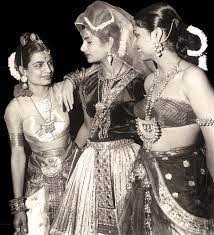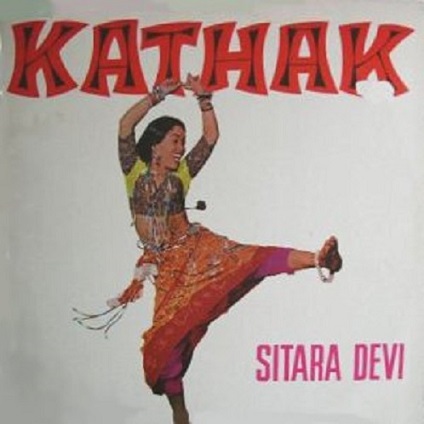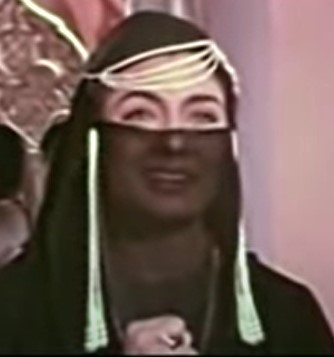
While I love all the classical Indian dances, I think it’s fair to say that my favorite is Kathak. (Or this, at least, has become my favorite in the past few years or so.) And while watching Kathak, I have often gotten the most enjoyment just from watching the footwork and the parts that focus on it. In technical terms, this aspect of the dance that I love is called “tatkar.” But I hesitate to use that word too much in my own descriptions, because real Kathak tatkar can get very complex, involving strings of “rhythmic syllables” and a very involved interaction between the dancer and (other) percussionists. If I try to figure out what makes genuinely great tatkar, I might end up going out of my element. So, let’s just say that I love the footwork – how it looks, how it sounds, and how it fits in with the music and the dance.
When I think of this Kathak footwork as it has appeared in movies, the kind of scene that I have most in mind is the one where the dancer is relatively stationary – not leaping around like a ballerina, etc. (which doesn’t happen in real classical Kathak) – and all the fancy moves of the dance are concentrated in the feet. The feet create a rhythm as they hit the floor, and the rhythm is enhanced by jangling of the ghungroos, those straps with numerous bells in them that are affixed around the ankles. The dance, itself, creates music and is therefore part of the scene’s soundtrack. We see this phenomenon in dances from other cultures, such as Flamenco and tap dance (which I also love), but I think it’s most apparent in Kathak. The music that comes out of a Kathak performance would not exist in its entirety without the dance, just as the dance could not happen in the absence of music. And I find that very interesting.
I have to say, I also really enjoy looking at the feet as they’re working. I have joked before that I may have developed a Bollywood-related foot fetish. I won’t speculate as to how true that might be – not seriously, anyway. But part of the fun here also comes from seeing the brilliant work of an instrument being played. In a Kathak film scene, a close-up on the feet is a close-up on the most prominent musical instrument.
So, with all this in mind, I decided that I would try to put together a list of scenes that emphasize or peak with this Kathak footwork, with at least some close-up on the feet and an emphasis on the music that they’re making. But when I started to think about the best footwork scenes that I’ve seen, I kept coming up with the same three dancers: Roshan Kumari, Gopi Krishna, and Sitara Devi. I might have dug up a couple of other examples (Vyjayanthimala could sort of break in with one scene or another), but the list would still be overwhelmingly weighed in the direction of these three people, whom we might consider the Kathak/tatkar royalty. So, finally, that is how I came up with this very narrowed down list and title.
And now, if you have managed to read through all of the overly long introduction above…
For the first scene, here is a delightful number from Parineeta (1953). Here, the close-ups on the footwork are fairly short, but they are prominent, and the scene, itself, is historically prominent because it shows one of the earliest film appearances for both Gopi Krishna and Roshan Kumari. (Actually, it was Roshan Kumari’s film debut, according the info that I have glimpsed.) Both dancers were definitely not yet out of their teens when they danced to this song – in fact, I don’t think they were beyond their mid-teens – but they still were fantastic.
A couple of years after Parineeta, Gopi Krishna made his famous debut as a star, in Jhanak Jhanak Payal Baaje. Here, he was maybe 17 or 18 years old. His co-star, Sandhya, was a bit older, somewhere in her 20s. But it was Gopi who taught her Kathak – just for this film (at the request of Sandhya’s husband, V. Shantaram) – and I have to admit that Sandhya (much as I love her) did not excel to being a Kathak dancer on par with Gopi or the other stars on this list. But the scenes of she and Gopi doing Kathak together still are famously wonderful! And among the many dance scenes in this film, I knew right away that I had to include the one for “Rat Basant Aayi Ban Upavan” (aka the “Raag Malika”) because the bulk of this scene consists of the stars’ dancing feet, superimposed over scenes of nature. After a short introduction, it’s all Kathak footwork!
Then, as I thought more about Gopi Krishna’s tatkar in Jhanak Jhanak Payal Baaje, I realized that I could not leave out the following dance scene, which occurs near the beginning of the film. It includes some magnificent footwork by Gopi and magnificent other stuff, too (and, obviously, Sandhya thought so also).
Now it is time to pay attention to Gopi’s aunty, Sitara. Her most incredible footwork scene, in my opinion, was in a dance that was very far from the traditional Kathak or mujra setting. It was the dance for the great snake (?) that she did for Anjali (1957). There is not much in the way of foot closeups here, but the whole dance is centered on the Kathak-style footwork, as you can see in the rapid vibrations of her body and as you can hear in the incredibly rapid jangling of her ghungroos.
There are a couple of somewhat Kathak-based dances by Sitara in Aabroo (1943). The one below contains some brief moments of very nice Kathak-based footwork. Understanding that this is in no way a real Kathak dance (it’s a bit more of a cabaret dance), nonetheless, I think there is enough classical influence here to qualify it. And besides, it’s just so nice!
Now, let’s move a bit ahead in time to include a scene from a classic documentary. Maybe it is cheating to include a piece of a film that isn’t fictional, but I couldn’t resist adding this scene because it is so great, and it does have some wonderful tatkar in it (done with the cutest red-colored toes, I might add). And it is still classic, coming as it does from a Films Division movie made in 1970.
…Which leads me to the greatest footwork scene, within the greatest Kathak scene, in the history of Indian cinema. Of course, a lot of people reading this would know what I mean without even taking a peek at the video below – that is, that I am referring to the dance in Satyajit Ray’s film, Jalsaghar… Within this greatest Kathak scene, I think the close-up on her feet doing the tatkar is truly spectacular. And as you can see, the hero (or perhaps anti-hero) agrees too, as he is totally mesmerized. Maybe the nawabs of yore also understood that there were few experiences as great as watching superb Kathak footwork.
————————
P.S. There is now a pretty perfect-looking description of Roshan Kumari at Wikipedia. It would be nice to learn who put this together, because it includes a lot of facts and speculated notions that have been thrown around here in this blog in the past, but that could never be located together in one place. I think, therefore, that this Wiki entry must be relatively new or newly expanded.




Richard,
Among Indian classical dances, Kathak is most accessible to lay viewers. Thanks for the nice compilation. Possibly Sakiya aaj mujhe neend nahi ayegi would also figure among great dances. Jalsaghar is a class apart; but, it is an interesting coincidence that Sahib Bibi Ghulam too has the same backdrop of decadent zamindars refusing to accept their decline.
AK
I loved your post, Richard. Thank you for this – especially for the section from Jalsaghar (and, I was just about to mention Saqiya aaj mujhe neend nahin… but see that AK has already pointed that out). The clip from the documentary is great, too (incidentally, the cute red stuff on her toes is called aaltaa. I remember us having put on our feet on highly festive occasions (as in Hindu festive occasions, such as around Navratri).
I have a particular fondness for Kathak, predominantly because of the footwork. In fact, I think when I was in school, most of the girls in my class (the boys were more interested in playing cricket) thought so too. One of my classmates used to learn Bharatnatyam, and I remember her bursting into tears when all of us told her we liked Kathak better. :-)
AK and Madhu, thank you both for the nice words and your comments.
It’s interesting that you both thought of “Sakiya aaj mujhe neend nahin ayegi.” It’s certainly a good Kathak-influenced mujra, and the dance is filmed in a fascinating way, with the use of shadows, the arrangement of the dancers, etc. But the dance doesn’t exactly have the part emphasizing real Kathak footwork – the tatkar – in the ways that I envisioned for the list here. Minoo Mumtaz dances in a very wide area, and there isn’t a part like the one I described at the beginning of the post, “where the dancer is relatively stationary…and all the fancy moves of the dance are concentrated in the feet.” (If you don’t mind me quoting myself :) …) And I don’t really hear the feet creating rhythms that become part of the music (outside of some general jangling that you can connect to ghungroos), which is something else I was looking for when I started to think about this list.
But maybe I was being a bit too narrow in terms of what I envisioned…. And, anyway, it is a moot point since I chose to limit the list only to the three dancers above. :)
AK, I have seen comparisons before between Jalsaghar and Sahib Bibi Aur Ghulam, with the point that you made (from different sources, possibly including you)… Yes, they deal with the same broad theme but ultimately in different ways. And I have seen Jalsaghar multiple times, including once within the past few years but watched Sahib Bibi… all the way through only once, close to nine years ago.There are reasons for that difference, though they’re both good films, but I don’t want to go too much into it, because that would make for a pretty long digression here.
Madhu, I wanted to answer a couple of other things that you mentioned – but I’ll do that in a separate comment so as not to mix up too many things at once. :)
Getting back to Madhulika now… I am glad that you agree that the documentary clip is great, and thank you for the information regarding the cute red stuff on Roshan’s toes! And it’s nice to see that you have that particular fondness for Kathak footwork, too.
Your school story is amusing. Of course, I do not have any comparable memories from my childhood and adolescence in The Bronx.
Do you think that the preferences might have leaned more toward Bharatanatyam if you were in South India? (I assume that during those school days in India, you were in the North, as you are now.)
The story that you’re relating kind of goes with the comment AK made about Kathak being “more accessible to lay viewers.” But I am not sure it is the most popular dance in the Indian diaspora throughout the west.
I am not absolutely sure it isn’t, either… But I know there’s something of a Bharatanatyam teaching industry here in the U.S. This American Bharatanatyam industry :) is talked about a little in the academic book called Sweating Saris, by Priya Srinivasan, which I reviewed as part of a post here some months ago. I got the impression from some of the things she said that families in the U.S. who have Indian origins are more likely to send their children (especially daughters) to learn Bharatanatyam than Kathak or other dances. (And then there are some very prominent dancers from the U.S. and Canada who have no Indian background at all who decided to devote their lives to Odissi. Where did that come from? :) )
Anyway, all of the classical Indian dances are great in their own ways, of course.
Back toward the beginning of this blog, I was looking more at Bharatanatyam, myself, maybe because that was when I became so fascinated with Padmini and Vyjayanthimala. But in the past few years, my heart has definitely gone more to Kathak, and I feel as though that isn’t going to change. :)
“Do you think that the preferences might have leaned more toward Bharatanatyam if you were in South India? (I assume that during those school days in India, you were in the North, as you are now.)”
Yes, my last five years of school were in Delhi, and almost all my classmates (even the girl who was learning Bharatnatyam) were North Indians, so there’s a strong possibility that our perceptions were coloured by the milieu we’d grown up in. Interestingly, though, considering the amount of influence TV had on our lives, I’d have expected less strong views on what we liked and what we didn’t. :-D Back then, the national TV network (Doordarshan, as it’s called) had just two channels, so out of sheer want of options, most of us ended up watching whatever was on TV – and Doordarshan showed a lot of performances of classical dances, with Kathak being just one of many.
I have a feeling we – nasty schoolgirls that we were – probably ribbed our friend even more when we realized just how passionate she was about Bharatnatyam. I can safely say that even back then I liked Kathak more; I think some of my other friends were probably ambivalent and joined in the ragging just for the sake of it.
I hear you about the difference between Saqiya aaj mujhe neend nahin aayegi and the other clips you’ve posted… yes, there is that.
It is difficult for me, as someone who went to school in The Bronx, to picture a high school kid getting ribbed or picked on for liking the less popular classical dance. : ) On the other hand, my sister (my bari behen) was a serious aspiring ballerina until her late teens, and she went to the High School of Performing Arts based on her dance skills, so maybe she had high school peers who would debate with her about dance. But I don’t really know that for certain…
Strangely enough, outside of YouTube (where I have watched quite a few dances that had first been broadcast on Doordashan), I had the most exposure to TV broadcasts of Indian dance in 2003-4, when I lived in run-down neighborhood in Staten Island. At the time, I had a Sri Lankan landlady who provided the entire building of three apartments with the cable TV package that she had obviously picked a long time ago. For years before I and my roommate moved into the top floor, the area had been occupied by the landlady’s son (who was an old acquaintance of my roommate’s), and maybe the landlady had lived there once too. Maybe that’s the reason that we got the “Desi” TV station.
At the time, I had a midnight shift on Friday and Saturday nights (not much different from some of the crazy shifts I’ve worked more recently), and sometimes when I came home early on Sunday morning, I would turn on that station to find the bible-preaching Christian dance show. (If I’m recalling correctly, the dance that I saw there most often was Bharatanatyam, similar to the Christian Bharatanatyam dances that I posted here and/or on Facebook on some Christmases past. And it was just the right, dreamy kind of show to watch before going to sleep!)
But I probably got my first big inspiration to check out classical Indian dance from a woman who was from somewhere even north of North India. That was the Pakistani woman who was my girlfriend for about half a year 20 years ago. I can only credit/blame her for other cultural influences in an indirect way (I had been a fan of some form or other of Indian music since way before), but I became much more curious about classical Indian dance specifically after she mentioned how much she LOVED classical Indian dance.
But it wasn’t until a period of time starting about ten years later that I’d learn what all the different dances were and what to expect from them. I guess we all know how that happened. :)
Anyway, Madhu, I guess you inspired me to go over another personal history. :) Obviously, I had a different experience from anyone who learned about all the dances just as a part growing up.
“I guess you inspired me to go over another personal history. :) ”
And very interesting, too! Thank you for sharing that, Richard – it’s always intriguing to learn how other people who share one’s own interests came by their interest in that subject.